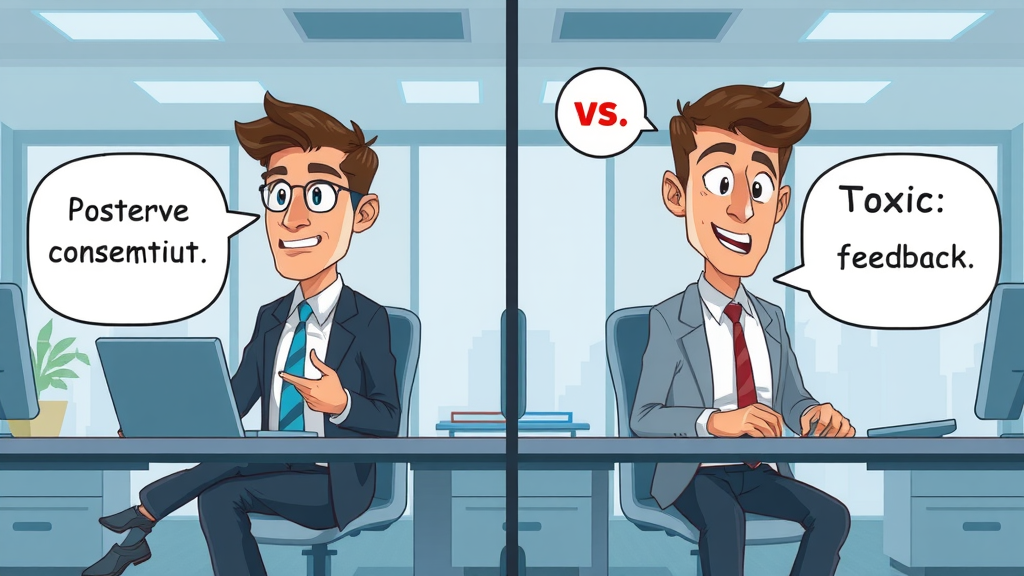What if every negative comment could become your biggest opportunity? If you think handling negative feedback is simply damage control, think again. The smart way to handle negative feedback doesn’t just save customer relationships—it can drive loyalty, inspire innovation, and turn critics into brand advocates. In this comprehensive guide, you’ll learn how to respond to negative feedback effectively, embrace a growth mindset, and build a robust feedback loop that powers your business forward. Let’s unravel the true power of critical feedback—starting now.
Are You Reacting to Negative Feedback or Responding Effectively?
Many businesses stumble when they react emotionally to negative feedback, inadvertently harming their brand or alienating valuable customers. An emotional reaction—whether it’s a defensive reply or total silence—can exacerbate the problem, making a bad situation worse and potentially leading to long-term customer loss. Instead, thoughtful responses to negative feedback show customers you value their opinion and are committed to making things right. This approach is a springboard for building trust and reinforcing loyalty, even after a negative experience.
When you respond to negative feedback with empathy, professionalism, and a cool head, you protect your business reputation and, more importantly, strengthen the underlying relationship with your customer. Critical feedback isn’t just a hurdle; it’s an opportunity to glean insights you might otherwise miss. Those who embrace criticism often uncover hidden opportunities—whether it’s refining your service, developing a new product feature, or simply showing your human side. Handling negative feedback with skill can transform crises into catalysts for growth.
- Why emotional reactions can damage your brand: Emotional replies amplify conflict and deter valuable dialogue.
- The impact of thoughtful responses to negative feedback on customer loyalty: Professionalism and empathy foster deeper connections.
- The hidden opportunities in critical customer responses: Criticism highlights areas for improvement and innovation.

Understanding the Importance of Handling Negative Feedback
Why Handling Negative Feedback Matters for Business Success
Businesses that prioritize handling negative feedback set themselves up for lasting success. Research consistently shows that companies actively engaging with feedback—especially the negative kind—retain more customers and see improved satisfaction scores. When you respond to negative feedback appropriately, you demonstrate accountability and a willingness to improve, which earns long-term trust. In the digital age, a single negative comment on social media or a poorly handled review can quickly damage your online reputation, deterring potential new customers.
A growth mindset transforms criticism into opportunity. Instead of dreading reviews that point out flaws, successful businesses view them as a tool for personal and professional development. Embracing feedback with an open mind lets teams continually evolve, keeping your business agile in a rapidly changing market. Remember, every piece of negative feedback is an opportunity for growth—a sentiment echoed by thought leaders across the business world.
- Insights from research on customer retention: Engaged feedback management prevents churn and fosters loyalty.
- The correlation between negative feedback and online reputation: Quick, thoughtful responses minimize digital backlash.
- How growth mindset turns criticism into opportunity: Teams that see feedback as a chance to improve stay competitive.
"Your most unhappy customers are your greatest source of learning." – Bill Gates
Best Practices to Respond to Negative Feedback Professionally
Steps to Respond to Negative Feedback Effectively
Crafting an effective strategy to handle negative feedback is essential for building customer trust. Start by promptly acknowledging the criticism, as delayed replies can signal indifference. Always apologize and empathize—even if you feel the feedback is unjustified—because your goal is to validate the customer's emotions. Address the customer with genuine concern and avoid canned statements, which tend to feel insincere. When appropriate, offer practical solutions or compensation to show your commitment to making things right.
Actively listening to your customers is the foundation of any successful response. This means reading or hearing their concerns fully before crafting your reply. Analyze whether the feedback is constructive criticism or simply an emotional outburst. In some cases, it’s best to respond publicly (such as on social media) to showcase transparency, while others are better handled privately to protect the customer’s privacy. Always close the feedback loop by following up—let customers see the outcome of their input.
- Immediate acknowledgment vs. delayed reaction: Timeliness matters, as immediate engagement demonstrates care.
- Apologize and empathize: Express understanding and regret if the situation merited it.
- Offering solutions or compensation: Where warranted, show you're proactive about solving their issue.
- Listen actively using active listening skills
- Analyze the feedback: Is it constructive criticism?
- Respond to negative feedback publicly or privately, as appropriate
- Close the feedback loop with follow-up

Video: Real-World Example of Handling Negative Feedback
Visual demonstration of turning criticism into an improved customer experience
Observing real-life scenarios can make all the difference when it comes to responding to negative feedback. In this video example, a customer expresses disappointment over a product malfunction on social media. The support team listens, responds promptly in a respectful tone, and offers step-by-step assistance to resolve the issue. By embracing feedback with an open mind—rather than dismissing or downplaying the problem—the team wins the customer’s trust and transforms a negative experience into a positive one. Such cases demonstrate the power of active listening and the value of a feedback loop for ongoing improvement.
Growth Mindset: Turning Negative Feedback into Personal and Business Growth
Adopting a Growth Mindset to Handle Negative Feedback
Adopting a growth mindset is a game-changer in how businesses handle negative feedback. When you view feedback as an opportunity for growth, you encourage personal growth and professional development within your team. Feedback—both positive and negative—becomes a catalyst for meaningful change rather than a source of conflict or insecurity. Leaders who foster a growth mindset model resilience and openness, paving the way for a culture of continuous improvement.
By using positive feedback to motivate change and negative feedback to highlight areas for improvement, you promote innovation at every level. Encouraging your team to embrace all forms of feedback leads to better performance, stronger collaboration, and increased morale. Businesses that prioritize a culture of continuous improvement consistently outperform those that don't, as they're always learning, adapting, and staying one step ahead.
- How feedback fuels personal growth and team development: Honest reviews identify skill gaps and learning opportunities.
- Using positive feedback to motivate change: Celebrate successes to inspire further progress.
- Encouraging a culture focused on improvement: Make feedback a regular part of your business DNA.

Constructive Criticism Versus Toxic Comments: Knowing the Difference
| Type | Examples | Recommended Response |
|---|---|---|
| Constructive | Actionable suggestions | Thank, act, follow-up |
| Toxic/Destructive | Personal attacks, vague | Acknowledge, stay professional |
It’s crucial to differentiate between constructive criticism and toxic or personal attack comments. Constructive criticism usually comes with specific examples and actionable insights, aimed at helping you improve. In contrast, toxic comments often include broad negativity—sometimes even personal attacks—offering little value and requiring a measured, professional response. Recognizing the intent behind feedback allows you to act appropriately, ensuring productive exchanges and avoiding unnecessary drama.

Active Listening: The Foundation of Responding to Negative Feedback
Using Active Listening to De-escalate and Manage Emotions
Active listening is an essential tool for responding to negative feedback. It means fully concentrating on the customer’s communication—whether spoken or written—without interrupting or preparing your defense. By paraphrasing and reflecting back what you’ve heard, you help the sender feel truly understood, reducing defensiveness and paving the way for a constructive conversation. This approach prevents escalation and signals your respect for their input.
Avoiding defensive reactions is a learned skill that takes practice and intention. When you remove ego from the equation and instead focus on the message, you can build a feedback loop that empowers both customers and staff. Teams that prioritize active listening transform tense situations into opportunities for connection, learning, and improvement.
- Paraphrasing and reflecting: Summarize key concerns to confirm understanding.
- Avoiding defensive reactions: Stay objective, focusing on facts, not emotions.
- Building a feedback loop with your audience: Encourage ongoing dialogue that supports continuous improvement.
Video: How Active Listening Changes the Game When Handling Negative Feedback
Practical examples of real-time customer service response
In this video, observe customer service representatives leveraging active listening to respond to negative comments. Through empathetic questioning, acknowledgment, and patient dialogue, negative feedback is transformed into actionable steps and resolved quickly. By mastering active listening skills, professionals can flip even the most challenging customer interactions into positive, loyalty-building experiences.
Step-by-Step: How to Respond to Negative Feedback on Different Platforms
Responding to Negative Feedback on Social Media, Email, and Review Sites
Every online platform requires a slightly different approach to handling negative feedback. On social media, responses must be public, prompt, and concise, as discussions are visible to other users. Review sites call for respectful, detail-oriented replies—often visible for years—while email allows for more nuanced, private exchanges. No matter the channel, always assess the feedback’s potential reach before responding, and tailor your reply to match the platform’s tone and context.
Documenting customer interactions isn’t just good practice; it’s essential for ongoing quality improvement. Recording the details—not just the outcome—lets you identify patterns and train your staff more effectively. As you create a culture of continuous improvement, use this documentation to refine protocols, promote positive engagement, and decrease the likelihood of repeat issues.
- Assess the feedback’s public reach
- Craft a custom response per platform
- Document interactions for quality improvement
Handling Negative Feedback in the Workplace: Turning Detractors into Advocates
Internal Protocols for Handling Negative Feedback
Negative feedback isn’t just an external threat; it exists internally within every organization. Smart companies establish clear protocols for managing criticism among staff, from entry-level employees to senior leadership. This includes coaching all staff on feedback management, building a positive feedback loop among teams, and providing regular training in active listening and conflict resolution. When teams model professional, solution-focused responses internally, it trickles outward, shaping the culture as a whole.
Internal feedback offers a massive opportunity for personal and professional development . Regular coaching sessions and peer reviews help individuals understand their strengths and weaknesses, building trust and cohesion. Creating a safe, supportive space for giving and receiving feedback ensures your team is always learning and adapting—two key ingredients for long-term business health.
- Coaching staff on feedback management: Employees learn to see feedback as a tool for personal growth, not punishment.
- Building a positive feedback loop among teams: Promote open dialogue to prevent misunderstandings and nurture a growth mindset.
- Implementing regular training for active listening: Consistent development helps everyone respond to feedback with professionalism and empathy.

People Also Ask: Addressing Common Questions About Handling Negative Feedback
How to deal with negative work feedback?
- View feedback as an opportunity for personal growth and skill development—embrace it as a tool for personal and professional development .
- Request clarity and ask for actionable steps to ensure feedback is constructive, not just critical.
- Remain professional, respond thoughtfully, and create a follow-up plan to demonstrate your commitment to improvement.
How do you respond to a negative feedback?
- Acknowledge the concern promptly to assure the customer you are listening.
- Validate the customer’s emotions using empathy and active listening, showing that you understand their feelings.
- Provide a concrete plan to address or resolve the issue, offering next steps and follow-up communication.
How do you control negative feedback?
- Monitor platforms closely and respond proactively to head off bigger issues.
- Use feedback to inform service improvements and demonstrate your commitment to customer satisfaction.
- Encourage a balanced feedback approach, inviting both positive and constructive criticism for ongoing growth.
What are the 4 steps of negative feedback?
- Recognize and acknowledge the feedback
- Analyze the underlying issues
- Formulate an appropriate response
- Implement changes and follow up
Video: Responding to Negative Feedback in High-Stakes Scenarios
Case studies from industry leaders on recovering after public criticism
In high-stakes situations, such as viral social media incidents or major product recalls, the way companies handle negative feedback is under intense scrutiny. In these video case studies, industry leaders share how transparent communication, public acknowledgment of errors, and clear plans for remediation restored customer confidence and strengthened their brands. From open CEO apologies to customer panels for public Q&A, each example underlines that honesty and humility are vital to recovery and long-term success.
Building a Feedback Loop for Continuous Improvement
- How a feedback loop supports long-term customer loyalty: Regular review, response, and action build trust over time.
- Feedback integration into process and culture: Proactively adapt to recurring issues and showcase commitment to quality improvement.
- Tracking and measuring the impact of changes post-feedback: Use data and customer sentiment to measure progress and adapt strategies.
A well-designed feedback loop is integral to continuous improvement. By tracking feedback, acting on insights, and closing the loop with customers, organizations can identify trends, prevent recurring issues, and prove their dedication to service excellence. Integrating feedback into your company culture ensures everyone takes responsibility for quality and growth, not just the customer service team. Over time, this transforms feedback from a threat into your greatest strategic asset.

Common Mistakes When Handling Negative Feedback and How to Avoid Them
- Ignoring negative feedback: Silence breeds resentment and signals a lack of care. Always acknowledge and address criticism.
- Responding defensively: Defensiveness escalates the conflict and harms your brand reputation. Stay objective and professional.
- Failing to act after promising change: Empty promises destroy trust. Always follow through and communicate progress.
Frequently Asked Questions about Handling Negative Feedback
- Should I reply to every negative review? Yes, acknowledge all genuine concerns promptly. This demonstrates accountability and respect, even if the review is minor.
- What tone should I use in my replies? Use a calm, empathetic, and professional tone. Avoid being defensive or dismissive, even in the face of harsh criticism.
- How do I know if feedback is genuine or spam? Genuine feedback will include specific details or actionable insights. Spam usually contains vague complaints or personal attacks with little context.
- Can negative feedback help my business grow? Absolutely! Responsive handling of negative feedback provides actionable insights and proves your commitment to improvement, strengthening customer loyalty.
Key Takeaways: Mastering the Art of Responding to Negative Feedback
- Proactive, empathetic responses can turn critics into loyal customers.
- Focus on active listening and adopting a growth mindset for effective results.
- Embrace constructive criticism as a pathway to continuous improvement and innovation.
Ready to Transform Negative Feedback Into Your Competitive Advantage?
Tired of being overlooked online because of weak or missing reviews? Let us help you implement a custom review strategy that works. Book your free consultation today!
 Add Row
Add Row  Add
Add 




Write A Comment